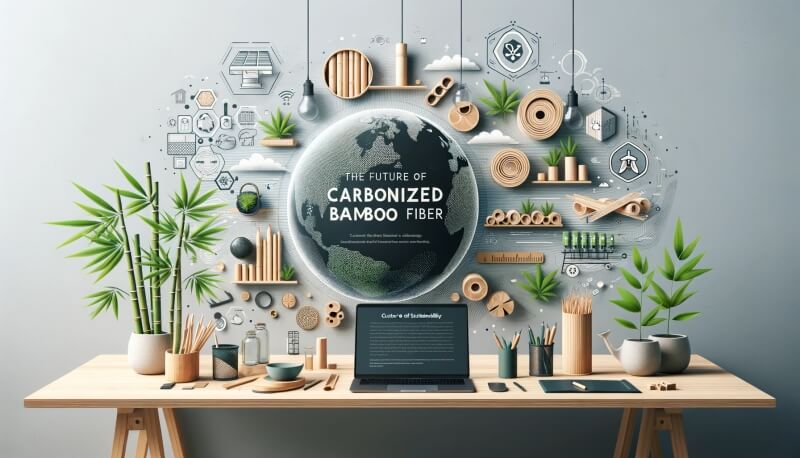Established in 1999, MesidaBamboo has grown from a pioneering brand into a beacon of sustainability and innovation in the bamboo industry. As a professional manufacturer of carbonized bamboo sleeping mats, we pride ourselves on our commitment to quality, sustainability, and the advancement of bamboo technologies. In this exploration, we delve into the unique world of carbonized bamboo fiber, highlighting its myriad applications and the benefits it brings to various industries, including ours.
Key Takeaways
| Feature | Description |
|---|---|
| Production Process | Carbonized bamboo fiber is created through a process of heating bamboo at high temperatures, changing its color and enhancing its properties. |
| Properties | Noted for its durability, resistance to moisture, and aesthetic appeal, carbonized bamboo is an environmentally friendly alternative to traditional materials. |
| Applications | Beyond flooring and textiles, carbonized bamboo fiber finds innovative use in high-performance materials, such as supercapacitors. |
| Challenges | While it offers numerous advantages, the material is not immune to scratches and is susceptible to moisture, which can cause warping over time. |
| Sustainability | Carbonized bamboo is a sustainable choice, derived from a fast-growing, renewable resource. |
For more insights and detailed product information, visit our Product Page.
Introduction
In the realm of sustainable materials, carbonized bamboo fiber stands out for its exceptional qualities and versatility. Derived from one of the fastest-growing plants on the planet, carbonized bamboo undergoes a high-temperature treatment that not only darkens its hue but also enhances its strength and durability. This process results in a material that is not just aesthetically pleasing but also environmentally friendly and highly functional.
Understanding Carbonized Bamboo Fiber
Definition and Production Process
Carbonized bamboo fiber is a result of thermal treatment, where bamboo is heated at extremely high temperatures until it achieves a rich, caramelized color. This process alters the physical structure of the bamboo, making it denser and more resilient. Unlike traditional bamboo products, carbonized bamboo boasts a deeper, more uniform color, offering both beauty and durability.
Comparison with Other Bamboo Fibers
In the broader family of bamboo materials, carbonized bamboo distinguishes itself from its counterparts – regenerated and bast bamboo. Regenerated bamboo, often used in textiles, is known for its smoothness and sheen, while bast bamboo is appreciated for its coarse, natural texture. Carbonized bamboo, however, offers a unique combination of durability and aesthetic appeal, making it a preferred choice for a wide range of applications, from home décor to innovative industrial uses.
Material Properties and Advantages
The allure of carbonized bamboo lies not only in its visual appeal but also in its remarkable properties. It is incredibly durable, resistant to moisture and scratches, and possesses a unique aesthetic that can complement any setting. Moreover, its environmental benefits cannot be overstated; carbonized bamboo is a sustainable alternative to hardwoods, requiring less water and no pesticides during growth, and it significantly reduces its carbon footprint thanks to its carbonization process.
Applications in Various Industries
Flooring Solutions
Carbonized bamboo is increasingly popular in the flooring industry, valued for its strength, durability, and unique aesthetic appeal. Its advantages include resistance to moisture and scratches, making it an ideal choice for both residential and commercial spaces. The installation process of carbonized bamboo flooring is similar to other hardwood floors but offers easier and more flexible options due to the material's engineered planks. Maintenance involves regular cleaning with mild detergents and avoiding excessive water exposure to preserve the floor's integrity and appearance.
Textile Industry
In textiles, carbonized bamboo fiber is celebrated for its softness, strength, and eco-friendliness. It is used in a wide range of products, from clothing to bed linens, offering a breathable, antibacterial, and absorbent fabric choice. This fiber is particularly appealing for its natural luster and smooth texture, enhancing the quality and comfort of textile products.
Advanced Applications
One of the most innovative applications of carbonized bamboo fibers lies in their use for supercapacitors, especially for wide-temperature applications. These fibers' high surface area and porosity make them excellent conductors, providing a sustainable alternative to traditional materials used in energy storage technologies. This application underscores the material's versatility and potential in advancing renewable energy solutions.
Challenges and Limitations
Technical Challenges
Despite its many benefits, carbonized bamboo fiber faces challenges, including susceptibility to scratches and moisture. These vulnerabilities can affect the longevity and appearance of bamboo-based products, necessitating careful handling and maintenance.
Market Limitations
Market acceptance and availability of carbonized bamboo products remain limited by misconceptions about the material's performance and cost. Educating consumers and industries about the benefits and sustainability of carbonized bamboo is essential for broader adoption.
Future Perspectives
Research and Development
Ongoing research into carbonized bamboo fiber aims to enhance its properties and expand its applications. Innovations in processing techniques and product design are expected to improve its durability, functionality, and market appeal.
Potential Market Growth
The future of carbonized bamboo fiber looks promising, with potential growth in various sectors including construction, textiles, and renewable energy. As awareness of its environmental and performance benefits grows, so too will its adoption in new and innovative applications.
Conclusion
Carbonized bamboo fiber stands out for its unique blend of sustainability, durability, and versatility. Its applications in flooring, textiles, and advanced technologies highlight the material's significant potential across industries. Despite facing challenges in market acceptance and technical vulnerabilities, ongoing research and development promise to enhance its properties and expand its use. As we continue to explore the possibilities of carbonized bamboo, its role in promoting sustainable and innovative solutions becomes increasingly important. MesidaBamboo remains committed to leading the charge in harnessing the power of carbonized bamboo, driving toward a more sustainable future with every product we craft.



